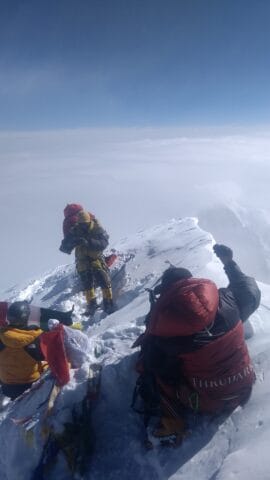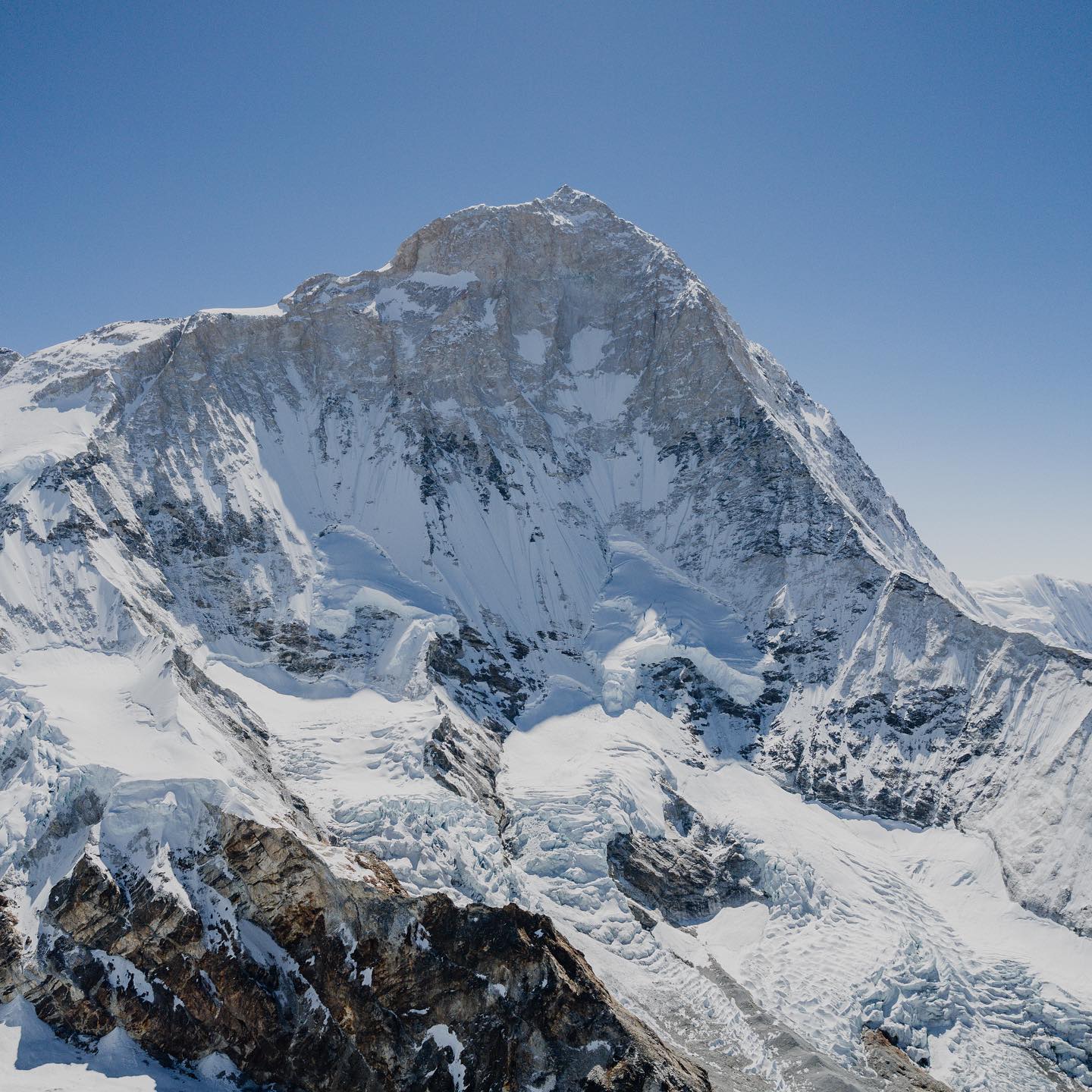K2 climbers are back home, and some are writing detailed reports on their experience. One that caught my eye was from American Eric Gilbertson as he described his no O’s, unsupported summits on K2 and Broad Peak with Danish climber Andreas Ritzau Frydensberg.
Meanwhile, there have been a few more summits in the Karakorum, but the mountain conditions are getting dangerous each day as the temperatures warm and moisture moves in. But, somehow, climbers continue to roll the dice. I hope their luck keeps up.
Big Picture
One of the topics from this summer’s Karakorum season has been the number of support the client climbers have needed, given their experience, and now about trash left on K2 allegedly from the large commercial teams. With around 200 summits on K2 and many on the other Pakistani 8000ers, 2022 was a season of excess: permits, inexperience, trash, and summits.
I’ve written for years about inexperienced clients, but, honestly, I never thought I’d be writing about them en mass on K2. But as I keep saying, times are a changn’.
Excessive Support
There is chatter about how Sherpas had to support inexperienced clients this season. They would take on and off their clients’ crampons, move their jumar across anchors, tell them when to walk and when to sleep, and more. This level of micromanagement is disturbing. Experienced climbers, especially on a mountain like K2, have this knowledge in their muscle memory.
But taking a step back, I think it’s unfair to make broad generalizations about climbers on these massive mountains. I’ve been on 38 major expeditions in my life, 14 climbing with Sherpas. I’ve seen it all. At times, a client is so fatigued that the Sherpa will take their crampons off or transfer some weight from their pack. I don’t have a problem with this because there have been times when I was so tired or fighting an attitude-related issue, like HAPE on my K2 descent, that I would have jumped on a horse if one came by. And I was grateful to climb with Kami Sherpa.
Also, many Sherpas have a sixth sense of when to help a client, going out of their way to help. This is second nature to some Sherpas and guides. This is not a bad thing. Western guides do the same thing. But it’s hard to know if this year’s observations are puffery from the support climbers, an honest appraisal of the situation, or petty jealousy amongst large egos. In any case, I think some of the clients dodged disaster with the decent weather and substantial support provided by their expedition operators.
So, what’s going on? Let’s put it this way. If a paying client needs help managing crampons, they shouldn’t be there. If a paying client can’t manage a jumar on a fixed rope, they shouldn’t be there. And if a paying client can’t carry their personal gear (clothes, sleeping bag/pad, water, food, etc.), they shouldn’t be there. And if a paying client is with a guide service that does all of this for the paying client, shame on the guide for accepting them in the first place.
Excessive Trash
On to the trash on K2 and a picture on IG of Camp 2 on K2. Again, sadly, this is nothing new, and there is no excuse for it, but there are reasons. Camp 2 is notorious as a tent graveyard, littered with shredded tents frozen into the steep mountainside. The issue is that hurricane-force winds can shred a tent apart in minutes. Teams will leave tents at C2 while climbing higher or returning to base camp. Instead of dropping them, covering them with a mesh net, or weighting them with rocks (if you can find loose ones), they are left set up and thus are easily destroyed. Some pieces are blown across the mountain, while others become frozen so hard into the mountain that it would take a superhuman effort to remove them. This is not unique to K2, as it happens on other mountains worldwide.
Again, no excuse. As for leaving empty oxygen bottles behind, while it happens, it’s also rare as each bottle costs US$600, but it happens in certain situations, rescues or an urgent descent due to weather, for example. As for leaving fixed ropes on the mountain, this is standard procedure, with clean-up operations occurring every few years.
Again, I implore all expedition operations, local and foreign, to follow Leave No Trace ethics on every climb, regardless of weather, schedule, or fatigue. This needs to be enforced to every employee, and every client at the beginning, throughout, and after each climb, without exception.
The Quiet Minority
There were many examples of self-sufficient climbers this summer, but they don’t get the same press as trash, crowds, and greed.
Danish climber Andreas Ritzau Frydensberg with American Eric Gilbertson summited Broad Peak on July 18th and K2 on July 28th without supplemental oxygen. They said they summited with three Italians around 8 am, and started at C4 at 11 pm, more than 2 hours later than the Italians.
On his website, Country Highpoints, Eric describes their Broad Peak, and K2 climbs in detail. They climbed unsupported, using Pakastani Alpine Adventure Guides for base camp services. So they climbed with no on-mountain support – no Sherpas to set up tents, cook food, or break trail. They also didn’t use supplemental oxygen.
They did use the fixed ropes put in by the commercial teams. They also used tents at some of the high camps with permission from their owners or that were obviously abandoned. And, of course, they did use a boot path when available. Also, they teamed up with other independent climbers to leverage power to break trail, for general moral support.
And, yes, they found themselves following some of the commercial teams but passed the oxygen-supported teams, even though they were climbing without. So as you can see, it’s always a challenge on how to characterize a climb using terms like “solo, alone, unsupported, or independent.” Andres told me, “Of course, the extensive sherpa support on especially K2 benefitted everyone.”
Before looking at their experience in detail, note that Eric is climbing the highest point in every country on earth – that’s 196!! Thus far, he and his twin brother, Matthew, have topped out in 135 countries. And, yes, they have all the US Highpoints, all 50.
In reading Eric’s excellent recap, a few areas stood out to me. He often writes about the “oxygen using, commercial clients,” but not in a judgmental style, just as an observation. He comments his choice of no O’s, no support:
Of course, I could always use supplemental oxygen on the summit, like most other climbers, but that feels like cheating to me. I also wanted to climb it unsupported above basecamp. People have recently started climbing k2 with sherpas carrying all their gear and setting up their tents and guides leading the way and making all decisions. I definitely did not want to get guided up and didn’t want anyone else carrying my gear up.
But he also recognizes the support that would be available:
Of course, I still wanted a reasonable chance of success, and that meant climbing the standard route, the abruzzi spur. This meant climbing with a bunch of other climbers. Inevitably they would help break trail, and I was ok with that. Also, because there would be guided groups they would of course fix ropes on crux sections for the clients. I was ok with paying to use fixed ropes on the mountain, as this is very standard practice on peaks like this. It would be silly to climb next to a fixed rope and not use it.
And he frames their expenses using Ali Saltoro of Alpine Adventure Guides:
Some climbers pay up to $95,000 (Madison Mountaineering) for a guided climb up k2, but we paid just $4,800 for permits and service for broad peak plus $2,000 for a k2 permit.
Actually, Madison charges $69,500 but point made.
And since he is a graduate of MIT in Mechanical Engineering, he’s smart enough to use some of these expenses to pay for professional weather forecasts from Colorado-based Chris Tomer. Finally, they went under the radar with no social media or pre-climb publicity, noting, “… I made one final decision, and that was to not tell anyone I was planning to climb k2 … I’m a fan of the climber mantra “send before you spray.”
 I hope to do a Podcast with Eric and Andreas soon, so I won’t go through his entire report but encourage you to read it as it describes what I feel is a very accurate description of climbing K2, dodging falling rock and oxygen bottles, constructive conversations with leaders of the commercial teams, and sharing camps and rope and more.
I hope to do a Podcast with Eric and Andreas soon, so I won’t go through his entire report but encourage you to read it as it describes what I feel is a very accurate description of climbing K2, dodging falling rock and oxygen bottles, constructive conversations with leaders of the commercial teams, and sharing camps and rope and more.
Also, the impact of so many people on the Hill this season. He also mentions Flor from Peru and Imman from Iran as independent climbers they team with. Flor made headlines with her Instagram post and a picture of shredded tents at Camp 2. Also, Serge and Mauritz completed the six-person independent team.
In that sense, let me cherry-pick this quote from Eric’s report. This is as they reached Camp 1 on K2 during their summit push:
By 10am we finally reached camp 1 and stopped for a break. That was the first flat spot since abc. The camp was deserted, with just a few tents still standing, likely abandoned. The camp stunk of excrement and had trash and flattened tents everywhere. There were perhaps 20 platforms created in the rocks and, precariously, in the snow at the edge of camp, but nearly all were empty. I was very happy to not have to camp there, especially when it was full.
I was surprised how much trash was in this camp given that the camps on broad were generally clean. Both peaks had a similar number of climbers registered for permits and c1 and c2 on broad were also small. The only difference I can think of is k2 has almost exclusively guided groups while broad had a high percentage independent groups. Perhaps independent groups clean up after themselves better and don’t leave old tents on the mountain? I’m not sure.
And at Camp 2:
Like c1, c2 was completely deserted. Four tents remained and they were all in tough shape and very likely abandoned. The trash situation in c2 was much worse than in c1. Most of the tent platforms were literally piles of old tents. There would be 10 flattened old tents, then a platform with a pile of trash on top. Empty fuel cans were everywhere, as well as food wrappers and all kinds of random junk. It’s as if climbers come down from the summit exhausted and decide they’d rather leave their gear and trash there and go down light and buy new gear later instead of carrying their gear down. This is terrible! All future climbers have to then deal with the trash! My LNT instructors from boy scouts would be appalled at this situation.
Eric suggested a clean-up expedition was scheduled, but I doubt it happened, “Luckily, I later learned a cleaning team is scheduled to go up and remove the trash if there’s a weather window. Hopefully, this is what our $200 environmental fee is helping to fund.”
Eric noted seeing the body of John Snorri, who died during the winter attempt in 2021, “Around 8400m I passed a dead climber curled up and tied to a rope. I later learned he was an Icelandic climber that had died on a 2021 winter attempt. I think it was too risky to remove the body from that altitude.”
Pakistani Ali Sadpara, Icelander John Snorri, and Chilean Juan Pablo Mohr Prieto all perished on their summit push on February 5, 2021. Ali’s body was taken lower, near Camp 4, for a respectful burial, and Juan Pablo’s was covered where he passed away. They left John alone per the wishes of his family. Snorri’s wife had asked for this year’s climbers to respect her wishes and not post pictures. She also requested that his body be moved out of sight. I don’t believe that happened.
Summary
I believe we saw an inflection point in high-altitude mountaineering in 2022. The style, profile, and manner we saw just a few years ago have given way to scale, support and selfies. As noted in this coverage of Eric and Andreas, “clean” climbs can still take place. There was no better example this summer than from Denis Urubko, who summitted his 27th (by his count) 8000er summit while not using O’s. This summer, he got K2, Broad, and GII, all alone with no O’s. But for the mass market they have access to expeditions the old-timers never believed would happen.
High-altitude mountain climbing is all about risk management. If an operator feels they can mitigate all the known and unknown risks through their experience, slick website, clever social media, and take on scores of paying clients with limited experience, both parties need to take a hard look at how mountains have a way of surprising and humbling even the best.
Summits Continue -Update
Gasherbrum II
Pakistani Shehroze Kashif, 20, summited Gasherbrum II, thus becoming the youngest climber to nab nine of the fourteen 8000ers. His quest is to be the youngest to summit all fourteen. Also summitting were Tawainese Tseng Ko-Erh aka Grace Tseng, 29, supported by Dolma Outdoor’s Nima Gyalzen Sherpa and Ningma Dorje Shehroze Kashif, Sajid Sadpara, Imtiaz Sadpara, Pema Chhiring Sherpa and Liliya Ianovskaia. Kristin Harila, Pasdawa Sherpa, and Dawa Ongchu got their summit as they try to get all 14 in record time. Some of these will now move to the much harder G I as they chase their respective records.
Update: Kristin Harila with Pasdawa Sherpa, and Dawa Ongchu have summited GI, leaving only three 8000ers to set the record of all 14 in six months. Then on August 8, 20222, six Pakistani climbers led by Sirbaz Khan with Naila Kiyani, Sheroze Kashif, Sajid Sadpara, Sohail Sakhi, and Imtiaz Sadpara all summited GI.
Climb On!
Alan
Memories are Everything
The Podcast on alanarnette.com
You can listen on Spotify, Apple, Google, Pocket Casts, RadioPublic, Anchor, and more. Search for “alan arnette” on your favorite podcast platform.
Summit Coach

If you dream of climbing mountains but are unsure how to start or reach your next level, from a Colorado 14er to Rainier, Everest, or even K2, we can help. Summit Coach is a consulting service that helps aspiring climbers worldwide achieve their goals through a personalized set of consulting services based on Alan Arnette’s 25 years of high-altitude mountain experience, including summits of Everest, K2, and Manaslu, and 30 years as a business executive.




